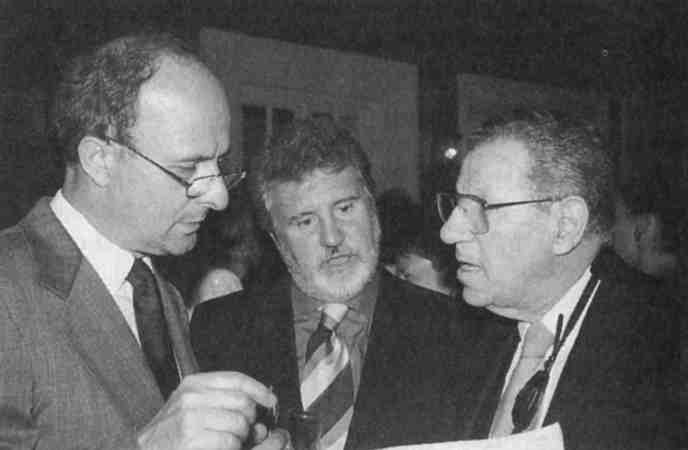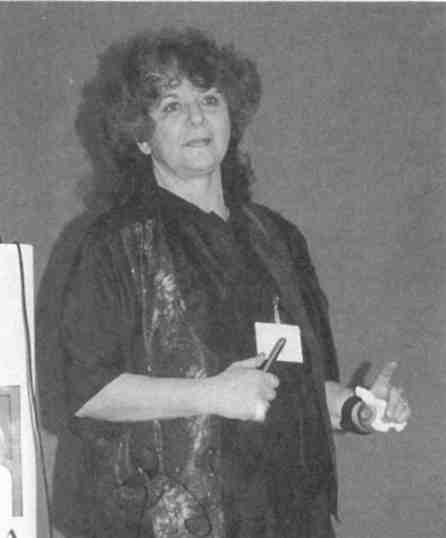


Meeting report
Bioactive Peptides: Naples
 Astonishing results? From left to right: L. Paolillo, E. Benedetti, and M. Goodman.
Astonishing results? From left to right: L. Paolillo, E. Benedetti, and M. Goodman.
On Sunday, May 22, 1994, 160 peptide scientists from all over the world gathered on the luxurious island of Capri in the Gulf of Napoli, Italy, to participate in the Fourth Naples Workshop on Bioactive Peptides. The meeting was organized by the Dipartimento di Chimica of the U. of Napoli "Federico II" and by the I.C.M.I.B. of the C.N.R. of Italy under the auspices of the European Peptide Society, the American Peptide Society, and the Regione Campania, Assessorato Pubblica Istruzione, Cultura e Ricerca Scientifica.
The main theme of the three day workshop is summarized by "CAPRI," the acronym for Conformation Activity in Peptides: Relationships and Interactions. The program offered ten Main Lectures, two in which short oral presentations were selected from among the 92 contributed posters.
The opening lecture, masterfully given by Nobel laureate R. Huber (Germany), concerned the structures and mode of action of natural inhibitors of proteolytic enzymes. The cystatin/stefin-papain and the hirudin-thrombin complexes were shown to reveal novel nonsubstrate-like interaction. Ligand-receptor interactions were illustrated by M. Rosenblatt (USA) for the parathyroid hormone and its related protein and for antagonists of the osteoclast integrin receptor which block bone resorption. The growing interest in these peptides stems from their potential clinical importance as therapeutic agents in hyperparathyroidism, hypercalcemia, and osteoporosis. A. Tramontano (Italy) and C. Pedone (Italy) lectured on the design and synthesis of metal binding peptides, which mimic the functions of naturally occurring metal-binding proteins. Accurate NMR studies of molecular complexes of immunosuppressants with their receptors and of antibodies with peptide antigens were illustrated, by S. W. Fesik (USA) and J. Anglister (Israel), respectively. The design and properties of templates for the induction of peptide folds were examined by K. Muller (Switzerland), with emphasis on the search for templates, for the induction of α-helices or β-turn structures. The aggregation of helical peptides containing only nonpolar side chains and ion channel formation by helical peptides was described in detail by I. L. Karle (USA). Restricted opioid peptide analogs derived from tetrahydroisoquinoline-3-carboxylic acid (Tic) were presented by P. W. Schiller (Canada) with their δ antagonist or mixed μ agonist/δ antagonist pharmacological properties. The importance of these materials as analgesics that do not produce tolerance and dependence was clearly pointed out. A. Yonath (Israel) described structural work which was carried out in various laboratories on the ribosome structure. Her description of the preparation of high quality single crystals from ribosomes, their complexation with metal salts, collection of synchrotron data at cryotemperatures, and the attempts at phasing diffraction data captivated the audience.
 A. Yonath lecturing
A. Yonath lecturing
The analyses of peptides and peptidomimetics by experimental and theoretical techniques were systematically explored in the posters and the short oral presentations given at the first round table entitled "The Structural and Conformational Behavior of Peptides", coordinated by C. Toniolo (Italy) and M. Marraud (France). In this session, ways of inducing peptide conformations were discussed by R. Haubner (Germany), H. Molinari (Italy), G. L. Millhauser (USA), A. G. Szabo (Canada), B. Pispisa (Italy), and M. Marraud, while J. Blazyk (USA) presented the effects produced on the conformation of membrane-bound antimicrobial peptides by interactions with cholesterol.
The second round table, "In Search of Bioactive Conformations", was coordinated by M. Goodman (USA), R. Schweizer (Switzerland), P. Temussi (Italy), G. Nikiforovich (USA), and J. L. Flippen-Anderson (USA). The structure and function of PMP-D2, a novel 35 amino acid peptide, Ca2+ inhibitor, was presented by G. Mer (France) and C. Kellenberger (France), while V. S. Ananthanarayanan showed lipid-dependent Ca2+ binding by peptide hormones and its possible use in assessing bioactivities of hormone analogs. D. S. Eggleston (USA) presented the structure of the lipopeptaibol Trichogin IV, a peptide having all L residues except the final amino alcohol which is a (D,L) mixture. The same author reported the first crystal structure of a complex between a glycopeptide antibiotic (Ardicin) and a peptide which represents the consensus binding recognition sequence for antimicrobial activity. Structure-activity relationships of cyclolinopeptide A and its analogs were analyzed from a variety of perspectives by F. Rossi (Italy), G. Muller and M. Gurrath (Germany) proposed the first three-dimensional structural model for an RGD-binding receptor, and G. B. Fields (USA) studied the effect of collagen conformation on tumor cell recognition processes by synthesizing aligned triple-helical collagen-model peptides, which were investigated by spectroscopic measurements. The conformation and dynamics of ureido-balhimycin, a peptide antibiotic, were investigated by D. F. Mierke, while M. Chorev discussed in detail the isolation, preparation, pharmacological effects and structure activity relationships of the osteogenic growth peptide, which stimulates bone formation and increases trabecular bone density.
The Capri Workshop offered the opportunity to learn about many peptide systems and the solution, solid state, and theoretical methodologies capable of structural and conformational analyses of these important compounds. All scientific discussions were harmoniously modulated by the unique environment and natural beauty of the island to make this experience rich, rewarding, and memorable.
Ettore BenedettiNapoli, Italy


